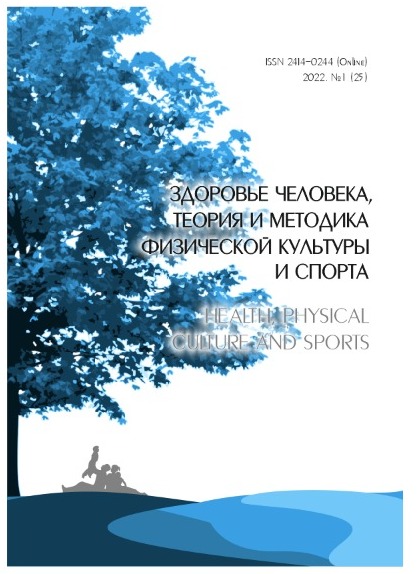Methods of studying the attractiveness of motor activity for students
Abstract
Over time, the importance of physical culture has been steadily increasing, which is a reflection of the tendency to improve the humanistic social paradigm. This turns us directly to man, his essence and existence. The issues of comprehensive and harmonious personal development are becoming more acute in the problems of physical education, which entails the need to solve the problem of the formation of productive motivation.The purpose of the study was to design and test a methodology for determining the attractiveness of motor activity for students.In the course of the study, the factors of attractiveness of motor activity were identified.1. The attractiveness of the actual process of performing motor actions (the manifestation of kinesophilia, the feeling of “muscular joy” during exercise, the enjoyment of excessive fatigue after exercise, the feeling of water, the feeling of snow, etc.).2. Attractiveness of sensations arising from the impact of social factors accompanying motor activity (disclosure of the phenomenon of team interaction, awareness of the advantages of a unique microenvironment of small social groups, feelings of cohesion, mutual sympathy, social security, mutual assistance).3. Attractiveness of feelings of struggle, victory, overcoming oneself, characteristic of physical culture and sports activities.
4. The attractiveness of feelings of one’s own worthiness, success in physical, cultural and sports activities, achievement of the intended result, productive transformation of oneself.
The presented structure formed the basis of the developed methodology, tested on students of the first and second courses of the full-time department of the Altai State University.According to the results of the study, it can be noted that the sensations from the very process of performing motor actions turned out to be the most attractive for students. The average value was35.9 points. Further, according to the degree of attractiveness, there are such blocks of questions as the attractiveness of sensations arising from the influence of social factors (34.2 points); the attractiveness of feelings of struggle, victory, overcoming oneself (32.8 points); the attractiveness of feelings of one’s own worthiness, success in physical culture and sports activities is 32.7 points.Thus, the attempt to build a methodology to determine the overall level of attractiveness of motor activity for students, as well as to identify the individual aspect ratio of this attractiveness for each interviewee gave its results. The demonstrated capabilities of the developed methodology are useful to us for use in the field of physical education pedagogy and, in particular, in solving the problem of forming the motivational and value attitude of students to physical culture and sports activities.
Downloads
References
Бакурадзе А. Три группы потребностей // Директор школы. 1997. № 2. С. 36–38.
Бакурадзе А. Иерархия потребностей // Директор школы. 1997. № 4. С. 14–17.
Белоуско Д.В. Ключевые особенности физкультурного воспитания // Наука и образование в 21 веке: сборник научных трудов по материалам Международной научно-практической конференции. М., 2015. С. 100–101.
Белоуско Д.В. К вопросу о сущности физкультурного воспитания // Здоровье человека, теория и методика физической культуры и спорта: материалы Международной научно-практической конференции / под общ. ред. П.Я. Дугниста, П.Г. Воронцова, Е.В. Романовой. Барнаул : Издво Алт. ун-та, 2015. С. 22–25.
Белоуско Д.В. Зеркальная индивидуализация // Здоровье человека, теория и методика физической культуры и спорта. 2017. № 4. С. 36–43. URL: http://journal.asu.ru/index.php/zosh/issue/view/213.
Белоуско Д.В. Предпосылки разработки модели зеркальной индивидуализации физкультурного воспитания студентов // Здоровье человека, теория и методика физической культуры и спорта. 2019. № 4. С. 3–10. URL: http://journal.asu.ru/zosh/article/view/7064.
Волкова Л.М., Шалупин В.И., Родионова И.А. Физическая культура как фактор формирования социального здоровья студентов авиационных вузов // Здоровье человека, теория и методика физической культуры и спорта. 2020. № 18. С. 23–28. URL: http://journal.asu.ru/zosh/article/ view/7946
Денисова Г.С., Тузова А.А., Гайдамака Т.А. Спорт как фактор формирования нравственности // Здоровье человека, теория и методика физической культуры и спорта. 2020. №4. С. 26–33. URL: http://journal.asu.ru/zosh/article/view/4.04.
Климов М., Мильхин В., Воронков И., Лашкевич А. К актуальности вопроса профессионально-прикладной физической подготовки как идеологии // Здоровье человека, теория и методика физической культуры и спорта. 2021. № 2. С. 14–17. URL: http://journal.asu.ru/zosh/article/view/9748.
Лопатина О.А., Жеронкина A.A. Роль физической активности в жизни студентов в условиях распространения новой коронавирусной инфекции // Здоровье человека, теория и методика физической культуры и спорта. 2021. № 3. С. 20–24. URL: http://journal.asu.ru/zosh/article/view/10456.
Снежицкий П.В. Двигательно-поведенческий аспект физической культуры личности в сельском сообществе // Здоровье человека, теория и методика физической культуры и спорта. 2021. № 4. С. 4–24. URL: http://journal.asu.ru/zosh/article/view/10666.
Усцелемова Н.А., Усцелемов С. В. Изучение опыта физкультурно-спортивной деятельности студентов технического вуза // Здоровье человека, теория и методика физической культуры и спорта. 2020. № 3. С. 86–96. URL: http://journal.asu.ru/zosh/article/view/8133.
Copyright (c) 2022 Health, physical culture and sports

This work is licensed under a Creative Commons Attribution-NonCommercial 4.0 International License.
An author should not normally publish manuscripts describing essentially the same research in multiple journals or publication venues. Such redundant publication is generally considered to constitute unethical publishing behavior, and if discovered may result in a manuscript under consideration being rejected, or a published article being retracted.
Authors of manuscripts reporting on original research should present an accurate account of the work performed, accompanied by an objective discussion of its significance. Underlying data should be represented accurately in the manuscript. The manuscript should contain sufficient detail and references to permit others to replicate the work. The fabrication of results and the making of fraudulent or knowingly inaccurate statements constitute unethical behavior and may be cause for rejection or retraction of a manuscript or published article.





